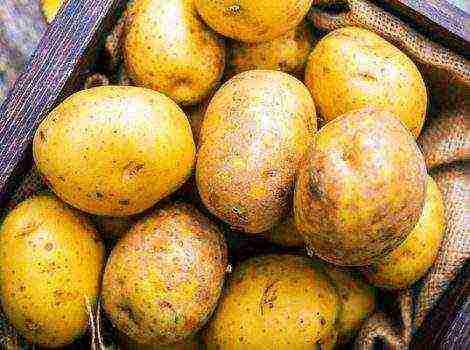Content [show]
The apple can be safely called a national fruit, since it is cultivated throughout Russia. However, each region has its own climatic characteristics and requires the selection of varieties adapted to it. What varieties of apple trees for Siberia are better to choose? First of all, winter-hardy varieties. In addition to frost resistance, the height of the tree is important - it will be more difficult for a strong-growing apple tree in Siberia to adapt to strong winds and prolonged frosts. That is why breeders have bred more than two dozen Siberian varieties of apple trees, which were created by crossing local apple trees with imported ones.
Main varieties
According to winter hardiness, Siberian apple trees are divided into 3 categories:
- highly winter-resistant are able to withstand a drop in temperature below -40 0С.
- medium-winter resistant withstand low temperatures down to -35 0С.
- poorly winter-resistant tolerate a drop in temperature to -25 0С.
Also Siberian apple trees are subdivided into the following varieties:
- Ranetki. Siberian Ranet is a small fruit variety, which is obtained by crossing Sibirka with European varieties. Apple trees of this species are more frost-resistant and high-yielding. And although they taste more tart and sour, they contain a lot of vitamins. Ranetki are the first generation of crossing Siberian varieties with imported varieties.
- Semi-cultural (semi-culture). This is the second generation of selection, when ranetki were crossed with large-fruited apple trees. Such fruits are not only larger in comparison with ranetki, but also tastier. The third and higher generations of semi-crops interbred with each other and with other large-fruited apple trees. Apples of this type have an average winter hardiness. Productivity is good, it starts in 3-4 years.
- Large-fruited. For more than 100 years, breeders have tried to breed large-fruited and frost-resistant apple trees for Siberia, and they succeeded. The size of the fruits of this species is comparable to the size of apples of such Central Russian varieties as Gorny Sinap, Tolunai, etc.
The best Siberian apple varieties are described below.
Altai Bagryanoye
It is an autumn species that gets its name from the color of the fruit. Ripens in the last months of summer and is stored for 2 months. Fruiting in the fourth year with a yield of 20-40 kg per tree. The apple weighs 25-30 g, juicy, sweet and sour. Medium-sized trees are scab resistant and winter-hardy. However, with sufficient prevalence, it is not very popular due to the small size of the fruit.
Bayan
Autumn apples reach maturity in early September, keeping quality up to four months. The first crop appears in 3-4 years. The yield is high, but intermittent. It is popular because of the large size of fruits for Siberia - their weight ranges from 80 to 140 g. The texture is dense, juicy with a pleasant aroma. Medium-sized trees are highly frost-resistant and immune to scab.
Gornoaltaiskoe
A late summer species that ripens in mid-August and is stored for up to three weeks. The harvest can be harvested from the fourth year, in terms of volume, however, it will be average. Fruits reach a maximum weight of 50 g. The fine-grained pulp is sweet, with a slight sourness. Medium-sized trees are scab resistant and tolerate winter frosts well.
Ermakovskoe mountain
Summer apples, which ripen in mid-August, are stored for up to a month. The first crop appears in 4–5 years, the yield is low. Fruits are medium-sized, reaching a maximum weight of 80 g. The pulp is fine-grained, sweet and sour, with a pleasant aroma. Low-growing trees have an average winter and scab hardiness.
Cherished
Winter, fast-growing and fruitful species, ripening in mid-September. The fruits are small, weighing no more than 60 g, and they can be stored for up to five months. The apple is juicy, the taste is sweet and sour with hints of strawberries. Low-growing trees do not tolerate frost well enough and can freeze under severe winters. Disease resistance is good.
Spartan
Winter early-growing species native to Canada. Ripens at the end of September and is stored until spring. Fruiting from the fifth year is generous, but uneven. The fruits weigh at least 160 g. The aroma is pronounced, with hints of wine, melon and strawberry. The pulp is juicy and crispy, the taste is sweet without sourness. The trees are medium to vigorous. Resistance to frost and scab is below average.
Tolunay
Refers to a late summer large-fruited variety. The first crop gives in 4–5 years. It ripens at the end of August. Shelf life up to 1.5 months. The maximum weight of the fruit is 130 g. The fruit is juicy, aromatic, with a sweet taste with a slight sourness. Medium-sized trees have medium winter hardiness and good scab resistance.
Sokolovskoe
Natural winter dwarf. Siberia is the best place to grow. Brings a harvest for 3-4 years, after harvesting, the harvest is stored for three months. Apples weigh up to 140 g. Fine-grained, dense and juicy pulp has an excellent sweet and sour taste. Differs in good frost resistance and insensitivity to scab.
Altai souvenir
Altai species are represented by another autumn species, the fruiting of which occurs in 5–6 years. The crop is ready for harvest in early autumn, and is stored for up to three months. Fruits weigh about 130 g. The structure of the pulp is fine-grained, juicy, sweet and sour taste.
The Altai souvenir has medium-sized trees, well adapted to frost and scab, but vulnerable to moniliosis.
Zhigulevskoe
Late autumn variety. Fruit is removed during September and stored for 1–2 months. It is considered high-yielding, fruiting occurs in the fifth year. Fruits are large, weighing 120-200 g. The pulp is coarse, tender, sweet and sour taste. A tall, fast-growing species with medium winter hardiness.
Video "Super harvest of apples in Siberia"
From this video you will learn about which apple varieties take root well in the harsh conditions of Siberia.
Happy owners of summer cottages are always in a hurry to master their native weave in the shortest possible time. At the dacha, you want to have the whole set of fruits and berries, especially apples.And here, amateur beginners make the first and very serious mistake. They clutter the garden with a large list of crops planted without considering their environmental requirements and compatibility with neighbors. They are of little interest in the types of selected crops, which will require the appropriate space and area, and buy tall varieties with a spreading crown. In the struggle for survival, such crops will purposefully oppress small neighbors.
Apples on the branches
A small or large family needs a different amount of fruit and berry products, but everyone wants to have fresh fruits and berries for a long time. A thoughtful selection of varieties of the desired culture can serve as a fulfillment of desire. Breeders for different regions of the Russian Federation offer a huge list of varieties and they are all temptingly beautiful on color applications. However, the garden consists of perennials (for apple trees 30-35 years old) and it can be very difficult to correct the mistake.
To avoid mistakes, you need to think in advance what types and varieties of apple trees are suitable for your site, select the ones you like. Novice gardeners should begin acquaintance with the varieties in winter, using their garden diary, in which to enter the desired selected varieties and your possibilities when laying an apple orchard or planting several seedlings in a small cottage or land plot.
Varietal planning of an apple orchard
On a summer cottage of 6 acres for a family of 4-5 people, 5-6 varieties of apple trees are enough. Of these, 2 varieties are summer, 1 medium and 2 late. To decorate a resting corner, a decorative fence, you can purchase a couple of small-fruited varieties of apple trees (ranetka, chinese, paradise apple and others). In a garden diary, make a table in which you briefly describe the desired qualities of the fruit and select varieties for them.
Apple trees can be divided into several groups.
According to the habit of the bush: tall, semi-dwarf, dwarf, columnar.
Tall apple trees - crops with a plant height of up to 8 m, a well-developed root system that penetrates deeply into the soil (Zhigulevskoe, Belfleur-Kitaika). It is recommended to grow them only in areas where groundwater is below 3 m depth.
Semi-dwarf apple trees - crops up to 5 m high (Elena). For them, a site with groundwater occurrence no higher than 2.5 m is suitable.
Dwarf apple trees - crops are undersized, up to 2.5 m in height (Gloucester, Solnyshko). The root system is relatively shallow, located in a meter layer of soil. The varieties are suitable for areas with a high groundwater table (up to 1.5 m).
Cold-resistant: frost-resistant, thermophilic.
By species: summer, autumn, winter, late winter.
By taste: sour, sweet, dessert and others.
Apple tree with fruits
Apple varieties for the middle and northern regions of Russia
For the middle and northern regions of Russia, characterized by a cold climate with prolonged frosts, when selecting varieties of apple trees, one should focus on their frost resistance.
Winter-hardy varieties of apple trees are: White filling, Candy, Grushovka Moskovskaya, Borovinka, Antonovka ordinary, Anis scarlet, Zvezdochka, Medunitsa, Sinap, Moskovskoe, Elena, Solnyshko and others.
Recently, breeders have proposed new frost-resistant varieties that can withstand temperatures down to -35 ° C: Marat Busurin, Mayak Zagorya, Winter Beauty, Imrus, Brusnichnoe, Narodnoe, Young Naturalist.
The first place in winter hardiness from new varieties of apple trees is taken by the Gift to Grafsky, Skala, which can withstand 40-42 degrees of frost.
Of the varieties of apple trees that are not resistant to frost, one can distinguish: Cinnamon striped, Melba, Mantent, Champion, Augusta, Koreyanka, Vatutin, Freshness, Lobo, Bogatyr, Belfleur-Chinese, Pepin. However, this property does not detract from their other qualities. They are suitable for medium-sized regions with a short cold period, without persistent severe frosts.
Apple grade Antonovka
Winter-hardy apple varieties for the southern regions
When buying apple seedlings for your small garden, be sure to ask about its species. Crops intended for middle and northern regions (even frost-resistant ones) in southern growing conditions can die from return spring frosts.
For the south, apple trees are most suitable for the weather conditions: renet Simirenko, Babushkino, Buzhor, Wagner, Golden, Glory to the Winner, White filling, Arkad yellow, etc.
Apple varieties by species
Summer varieties of apple trees
By species, apple varieties are subdivided into summer, autumn, winter, late winter. Fruiting of summer and so-called dessert varieties begins in July, the main harvest peak is in August. But summer varieties do not have keeping quality. The shelf life of fruits does not exceed 1-2 weeks. They must be used for food immediately after harvesting. Pleasant sweet-sour or sweet, juicy pulp, with a strong, often honey aroma, induces an appetite.
The most prominent representatives of early or summer apples are Elena, Medunitsa, Bely naliv, Mantent, Melba, Grushovka Moskovskaya, Candy, Borovinka, Korichnoe and others.
Autumn varieties of apple trees
The first apples of autumn varieties appear at the end of August. The main fruiting occurs in September. Their keeping quality is low, and its duration does not exceed 2-3 months. The pulp is juicy, sweet with sourness. When choosing a variety of apple trees for your garden, keep in mind that it is the summer and autumn varieties that are used for winter preparations in the form of juices, compotes, jams and others. Winter-hardy autumn varieties can be stored for up to 3 months, retaining their taste.
Winter-hardy autumn varieties of apple trees include Narodnoye, Streyfling, Orlovskoye, Bessemyanka, Aromatnoe, Korichnoye, Koreyanka and others. Among them there are fast-ripening (Orlovskoe), sweet (Narodnoe). On the market you can always buy Koreyanka, Cinnamon striped, and other varieties of this type. Determine which taste and aroma you like best and enter the data in your garden diary.
For southern regions with "warm winters" apple varieties Champion, Aydaret are suitable.
Apple grade White filling Apple grade Candy
Winter varieties of apple trees
When choosing a variety of apple trees, the main attention should be paid to winter and late winter varieties, since they will provide the body with vitamins in the most impoverished period - February-April: Bogatyr, Antonovka, Welsey, Pepin, Zhigulevskoe, Zvezdochka, Aphrodite, Orlovskoe, Solnyshko and others.
The crop is filmed at technical maturity in September-October. They cannot be eaten immediately. Their taste is usually sour, some have a tart, coarse flesh. They are perfectly stored for six months, and Simirenko, Bogatyr, Zvezdochka do not lose their qualities up to 9 months of storage.
Many gardeners consider the Moskovsky variety to be the champion in winter hardiness and storage duration, whose fruits are stored until the next harvest. Winter varieties in the south, in the middle regions, need a long warm autumn, hot summer. During this period, apple trees accumulate the necessary sugars and aromatic compounds, which give a unique taste and smell to the fruits when they reach biological maturity, which occurs in the winter months (Simirenko, Antonovka).
Winter varieties of apple trees, as a rule, have good keeping quality. For long-term storage, winter varieties with a sour taste of fruits are worthy of attention: Berkutovskoe, Afrodita, Bogatyr, Moskovskoe later. Their high pulp density and sour taste limit their fresh use immediately after harvest. Possessing good keeping quality, winter varieties gradually ripen during storage and by February-March they gain the whole bouquet of taste: juiciness, pleasant sourness, aroma.
Late winter varieties of apple trees
Of the late winter varieties, the most famous are Bellefleur-Kitayka, Sinap, Lobo, Moskovskoye, Freshness.Varieties Lobo and Freshness are well stored for a long time, but they have mediocre winter hardiness, and Bellefleur-Chinese is distinguished by its tallness and large crown habit. All late winter (of the considered varieties) are large-fruited.
Columnar varieties of apple trees
A separate group includes columnar apple trees, which have recently been rapidly adapting to private garden estates. This type is remarkable in that it has no side branches. The crop grows in one trunk, the habit of the bush is 0.25-1.0 m, the yield is formed right on the trunk, the yield is high.
The varieties of apple trees of this type differ in their high resistance to diseases and pests, they are resistant to frost, but have a shallow penetrating root system. The length of individual roots does not exceed 25-30 cm and are located so close to the soil surface that even shallow loosening can damage them. The superficial root system of columnar apple trees requires attention, needs watering (2-3 times a week, followed by mulching) and top dressing. Drip irrigation is suitable for them.
Apple variety August
The best varieties of columnar apple trees that can be grown in the middle and Siberian regions are Vasyugan, Moscow Necklace, Senator, President, Ostankino, Triumph, Currency, Arbat, Medok, Jin, Dialogue.
Of these, the most frost-resistant, develop well and form harvests in the Siberian regions - the Moscow necklace and Vasyugan.
The summer varieties of columnar apple trees include Malyukha, President, Medoc. A very interesting variety Medoc. It belongs to the summer-autumn varieties, but is late-ripening. Fruits in technical ripeness are harvested at the end of August.
Winter varieties of columnar apple trees Amber necklace, Bolero, Currency, Moscow necklace are distinguished by their high keeping quality. The late-ripening variety Moscow Necklace is removed at the end of September. It retains its qualities until March.
Growing conditions for apple trees
Apple trees grow and bear fruit on average for 30-35 years. Therefore, when laying an apple orchard, and even when planting several seedlings, you need to be extremely attentive to the agrotechnical requirements of the culture.
Site selection
Apple trees do not tolerate low-lying places, where spring frosts slide and stagnate. From recurrent and prolonged frosts in all regions (including southern ones), complete freezing out or severe damage to flower buds and blossoming flowers of this culture is possible. This means that at the dacha you need to pick up a site that is elevated and protected from cold air currents. If possible, select a separate, with suitable conditions, area for 5-8 apple trees. So full care can be provided and the requirements for agricultural technology can be fulfilled.
In a small summer cottage, pay attention to the columnar apple trees. A small crop habit will allow planting up to 12-15 varieties on a relatively small area. Some gardeners planted them in a bed, creating a unique, elegant, "fragrant" path during the flowering and ripening of apples.
Apple trees don't like shade. They need evenly lit areas, and not occupied by someone else's root system. Therefore, try to plant young seedlings at a distance from old trees. If the site allows, you can plant apple trees in small groups in places that are suitable for environmental and agricultural requirements. In the garden diary, on the general plot of the site, mark the places allocated for the apple trees. The next concern is the composition and quality of the soil in the areas allocated for apple trees.
Soil for apple trees
For apple trees, neutral soils with a pH of 5.5-6.5 are necessary, provided with sufficient nutrients, especially nitrogen, with good drainage properties, it is possible of medium density (loamy chernozems, ordinary), but air and permeable with high moisture capacity. The most suitable are ordinary chernozems, loamy with a predominance of sandy loam, loess-like loam.On light soils, constant irrigation is necessary. Peaty, highly acidic soils, with a close location of underground waters, with stagnant waters after rains and irrigation are not suitable. Apple trees with a deep root system develop poorly and die early on sandy or clay-sandy soils.
Having picked up a good location and type of soil, you can buy seedlings in the spring and plant your apple orchard.
Attention! We ask you to write in the comments to this article: what varieties of apple trees do you grow, how much they satisfy you, how they correspond to the declared characteristics. Do not forget to indicate your region and features of agricultural technology. Thank you!
If you live in a harsh or changeable climate, but want a stable harvest of bulk apples every year, this article is for you. We have prepared a selection of the most proven frost-resistant apple varieties that will not disappoint you.
Breeders have developed a huge number of apple varieties. We will introduce you to those of them that are distinguished by good winter hardiness and early entry into fruiting.
Antaeus
An excellent variety for temperate climates and winters with a sharp temperature drop. The trees are usually of medium height, with a pyramidal or round crown. The fruits are very large, round-conical in shape. The main color of apples is green, over time the color changes to red, which manifests itself in the form of a blush. The greenish pulp is juicy, with a fragrant and tart aroma. Since it is a commercial variety, the costs of growing these apple trees are quite low. Apples are distinguished by good keeping quality, long shelf life and attractive appearance.
|
Entering fruiting |
Fruit weight (g) |
Harvest |
Shelf life (months) |
|
2-3 years |
200-250 |
End of September - beginning of October |
5-6 |
Auxis
The variety was bred in the Baltics and is designed for the vagaries of the weather in this region. The tree is medium-sized with a sparse rounded crown. Fruits are of standard size, but large specimens can also be found. As the ripening period approaches, they acquire a light yellow color with a red blush. The pulp is firm, yellow, juicy, with a pleasant dessert taste. Fruiting is regular, while the tree rarely suffers from scab, and the fruits retain their presentation for a long time.
|
Entering fruiting |
Fruit weight (g) |
Harvest |
Shelf life (months) |
|
For 5-6 years |
150-180 |
September |
3-6 |
Baltika
This variety was specially bred for the difficult climatic conditions of the northwest region. The tree is vigorous, with a panicle-like crown of medium thickening. The fruit is above average in size, round, without noticeable ribs. The main color of apples is light yellow, by the end of the season it is complemented by a blurred striped blush. The yield reaches 200 kg per tree. The pulp is firm, white and very juicy. The fruits are stored for quite a long time and at the same time do not lose their presentation.
|
Entering fruiting |
Fruit weight (g) |
Harvest |
Shelf life (months) |
|
5 year |
100-120 |
Beginning of September |
2-2,5 |
Bashkir handsome
This variety was bred by Bashkir breeders and is suitable for cultivation in the northeastern, northwestern and southwestern parts of the region. The tree is medium-sized with a sparse and spreading crown. Fruits are elongated-conical or rounded with wide edges. The color is greenish-yellow, subsequently diluted with red stripes. The pulp is juicy, dense, greenish-white. The variety is winter-hardy, scab resistant.
|
Entering fruiting |
Fruit weight (g) |
Harvest |
Shelf life (months) |
|
For 6-8 years |
90-100 |
Mid september |
2-3 |
Golden autumn
This is a typical apple variety for the middle zone, which was bred specifically for wintering in severe winter conditions. The tree is tall and strong with abundant foliage. Fruits are large, rounded-elongated. The color of apples is light yellow; towards the end of summer, a pale pink blush forms on them. The pulp is white, slightly greenish at the edges, very juicy and spicy, sweet and sour.Despite its good winter hardiness, the tree often suffers from scab and other diseases.
|
Entering fruiting |
Fruit weight (g) |
Harvest |
Shelf life (months) |
|
For 5-8 years |
200-250 |
September |
2-3 |
Cinnamon new
The variety is zoned for the northwestern, southwestern and southeastern regions. The tree is tall, with a rounded dense crown. Fruits are medium in size, conical in shape. The skin is greenish-yellow with a dull red blush. The pulp is creamy, juicy, with a delicate sweet and sour aroma. The tree shows high yields and is frost-resistant. The fruits are stored for a long time and do not lose marketability.
|
Entering fruiting |
Fruit weight (g) |
Harvest |
Shelf life (months) |
|
For 5-7 years |
130-160 |
Beginning of September |
3-4 |
Lungwort
The tree is tall and at the same time bears fruit abundantly during the first 10 years. The crown is pyramidal, with drooping branches. The plant tolerates Siberian frosts and is widespread up to the Krasnoyarsk Territory. The fruits are medium-sized, flat-round, the color varies from yellow-green to bright red crimson. The apples taste spicy, sweet, with a specific aroma. The pulp is light creamy, fine-grained, dense and juicy. The apple tree is almost not affected by rot and scab.
|
Entering fruiting |
Fruit weight (g) |
Harvest |
Shelf life (months) |
|
For 4-5 years |
100-150 |
End of August - beginning of September |
1-2 |
North synap
This is a late winter variety of apples that are stored for quite a long time. The trees are vigorous with a wide-pyramidal crown. Fruits are medium in size, slightly oblong, with smooth skin. Their main color is yellowish-green, over time, a brownish-red blush appears on it. The apples are juicy, with a sour-sweet, refreshing taste. Apple trees have specific requirements for the weather - summer should be warm and even hot, but in autumn the plants feel great in conditions of temperature changes. Also, trees rarely get sick with scab and powdery mildew.
|
Entering fruiting |
Fruit weight (g) |
Harvest |
Shelf life (months) |
|
For 5-8 years |
100-120 |
Early to mid-October |
5-6 |
Sunsedar
The Solntsedar variety is zoned for the Volgo-Vyatka and Ural regions. The tree is of medium height, the crown is broadly round, spreading and slightly thickened. Apple fruits are flat-round or truncated oval in shape. The main color of the fruit is light cream with pinkish-scarlet "painting". The pulp is snow-white with small streaks of a reddish hue, tender and juicy. The taste of apples is sweet-sour with a slight astringency aftertaste. The frost resistance of the variety is high, but at the same time, the trees are often affected by scab.
|
Entering fruiting |
Fruit weight (g) |
Harvest |
Shelf life (months) |
|
For 6-7 years |
75-110 |
Early august |
1,5-2 |
Ural bulk
The variety was bred by Ural breeders by crossing Ranetki red and White filling. The tree is vigorous with a rounded crown of medium thickening. Fruits are small with a light yellow skin and a bluish waxy bloom. The pulp is white, juicy, medium-grained. The taste of the fruit is sweet and sour. Large yields can be achieved by over-pollination with varieties that coincide in terms of flowering. The variety is characterized by adaptive properties, winter hardiness and scab resistance.
|
Entering fruiting |
Fruit weight (g) |
Harvest |
Shelf life (months) |
|
3-4 years |
40-60 |
Beginning of September |
1-2 |
There are actually much more winter-hardy varieties of apple trees, we have selected only the most proven and popular ones. You may also have favorite varieties that have proven their resistance to frost and temperature extremes. Write about them in the comments and share your impressions with our readers.
 If the main part of Russian gardening cannot be imagined without apple trees, then The Siberian region only at the beginning of the XXI century, it can be considered, received such an opportunity - to grow this fruit crop in their gardens.
If the main part of Russian gardening cannot be imagined without apple trees, then The Siberian region only at the beginning of the XXI century, it can be considered, received such an opportunity - to grow this fruit crop in their gardens.
Thanks to breeders, apple trees appeared that can survive in a harsh climate and delight Siberians with an excellent harvest. In a sense, they can be called "northern varieties."
What are the apple trees that will grow on Siberian soil, and what good varieties of apple trees there are for Siberia, we will consider below.
general characteristics
 Currently the variety of species is amazing... The most important event is considered to be the correct choice and adherence to all growing rules.
Currently the variety of species is amazing... The most important event is considered to be the correct choice and adherence to all growing rules.
Only in this case are these fruit trees capable of producing a decent harvest in prolonged cold climates.
For both Western and Eastern Siberia, this the fruit crop must have certain characteristics and requirements.
Such as:
- winter hardiness - resistance to prolonged frost. There are species with medium and increased winter hardiness, capable of withstanding frosts above 40 ° C. Not requiring a lot of sun and moisture;
- yield and early maturity... Nobody wants to grow low-fruiting apples or wait 5-6 years for the first fruits to appear;
- ripening terms. For such a cold climate, ripening should end before the first frost;
- plant resistance to all kinds of diseases... The main ones are scab, rot and fungal diseases of the apple tree. All kinds of pests who want to feast on leaves, bark and fruits of a tree cannot be ruled out;
- taste characteristics... Any gardener dreams of sweet or slightly sour fruit. Everyone wants juicy and aromatic apples;
- crop storage... The later the ripening period, the longer the storage.
Important! When planting a new variety, know all its characteristics and the recommendations of experienced gardeners on the conditions for its cultivation. This is the only way to decide which apple varieties are best for your garden.
The best varieties of apple trees for Siberia
All Siberian varieties distinguished by good or increased winter hardiness and scab resistance... Below you can see their photo with the name and description.
Summer
Ranetka Ermolaeva
Siberian apple variety medium-sized tree with small apples, not long-term storage (maximum 30 days). The yield of yellow-red apples is average. The first fruits appear around the fourth year.
Shows tolerance to disease. Used for processing or conservation.
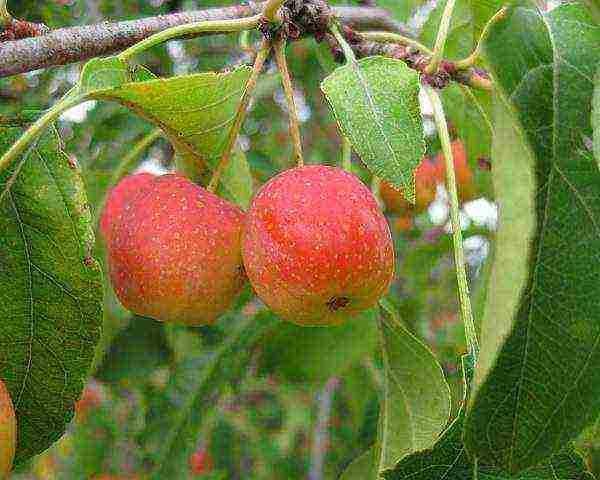
Ranetka Ermolaeva.
Read more about Ranetka Ermolaev's apple tree here.
Ermakovskoe mountain
In the last days of August, you can harvest green apples with a red coating. The first fruiting occurs at 4 or 5 years. The amount of fruit is not very large, with a one-month shelf life.
The tree is of moderate growth, with a rounded crown of medium thickening.
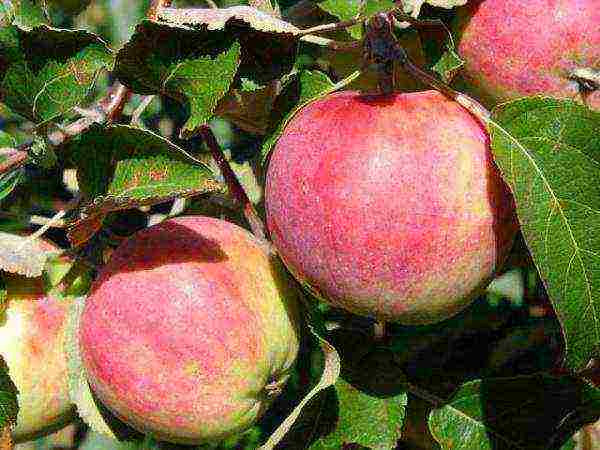
Ermakovskoe mountain.
Altai Bagryanoye
Enough fast early maturity. Even if it is exposed to severe frost, it tends to recover. Gives about 40 kg from a tree small, conical in shape and purple juicy, with tender pulp, delicious apples.
For a summer variety, it is stored for a rather long time - about 50 - 60 days.
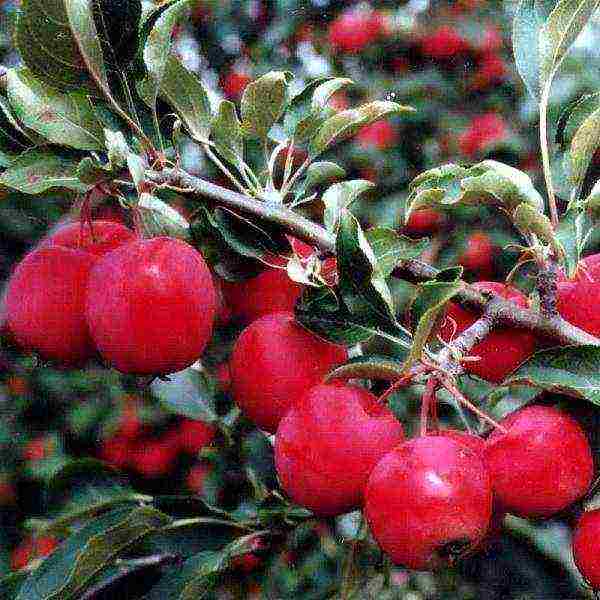
Altai crimson.
You can read more information about the Altai Crimson variety here.
Gornoaltaiskoe
The early maturity is average. Resistant to scab and frost. Stable moderate yield. Small tree. The apples are small, conical with a purple blush. Storage is not long, up to three weeks.
They need timely pick-up. In rainy weather during the ripening period, the skin on the fruit will crack.
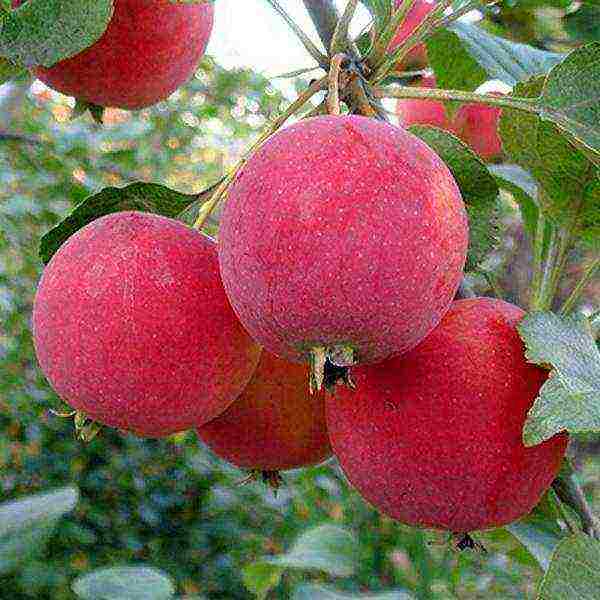
Gornoaltaiskoe.
Read more about the Gornoaltayskoye apple variety in this article.
Zhebrovskoe
Distinctive feature - a rare oval crown with a medium-sized tree. Very small fruits, round - conical in shape, with a basic light yellow color and a blurred red top color. The pulp is juicy, sweet with sourness and very aromatic.
The earliest apples in the Siberian region.
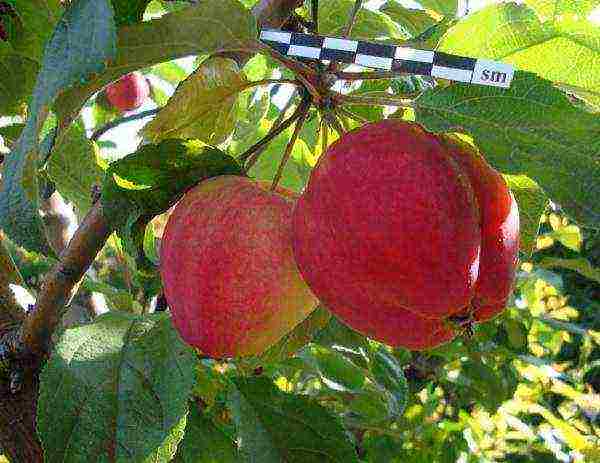
Zhebrovskoe.
Read more about the variety Zhebrovskoe in this article.
Melba
An old, proven and very beloved species by gardeners. Although it does not differ in increased indicators of winter hardiness, but with good cover with agrofibre, it successfully survives winter frosts. Differs in early maturity, early maturity and widespread use on an industrial scale.
The plant itself is small, with relatively large fruits, 150 g each. The pulp is very juicy, sweet with sour taste and candy aroma.
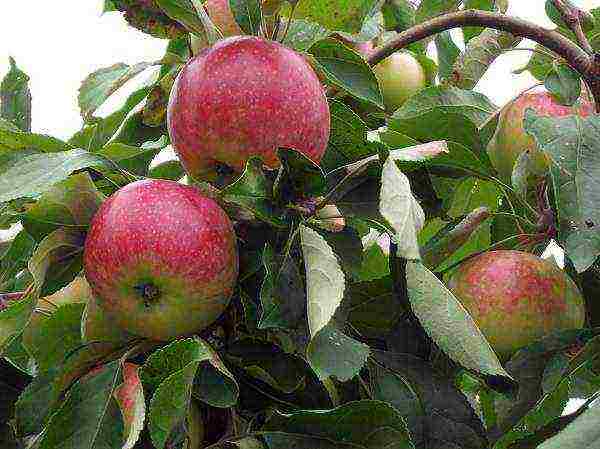
Melba.
You can read more information about the Melba variety here.
Minusinskoe red
Slow growing tree with a spreading crown. Small, slightly ribbed apples with a brick-colored coating on a golden background. The taste is sweet, aromatic. The pulp is tender and juicy. There is no scattering from the bush. Storage for about three weeks.
Important! Tolerance to fungal diseases.

Minusinskoe red.
Alyonushka
Fast-growing semi-dwarf. At the beginning of fruiting, growth slows down noticeably. The crown is drooping, of medium density, but very leafy. The apples are small, straw-colored with a red-pink coating. The pulp is fine-grained and juicy. Unusually spicy, aromatic, sweet and sour taste.
After planting, it bears fruit for 3-4 years. Not afraid of even severe frosts, but not very scab resistant.
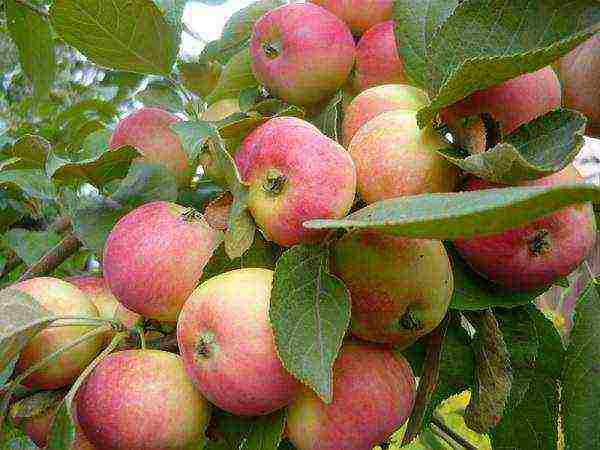
Alyonushka.
Read more about the apple tree Alyonushka here.
Autumn
They differ from summer ones in higher winter hardiness and better ripening of apples., which noticeably affects the taste.
Surkhurai
Among the best fruit crops for such a harsh region... The shrub grows medium in size, with fruits weighing up to 100 g. Their main color is golden, with crimson sheathing stripes throughout the fruit. Good taste characteristics.
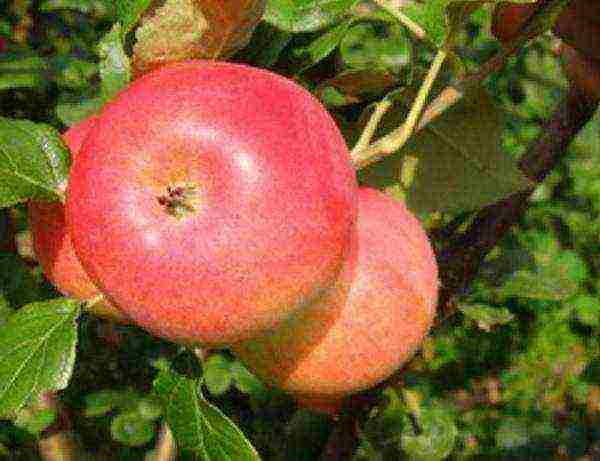
Surkhurai.
Read more about the Surkhurai variety in this article.
White filling
Russian vintage view of apple tree. All plant and fruit sizes are medium in size. The pulp is tender and juicy. The taste is wine-sour.
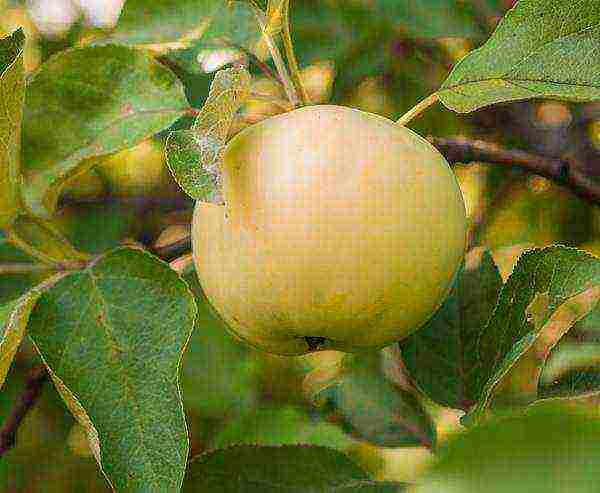
White filling.
You can read more information about the White filling variety here.
Tolunay
Apples from 80 to 130 g, conical and golden yellow with red stripes. The pulp is tender, juicy and rich in smell. Has a high tasting rating - 4.8. Suitable for use for 1.5 months.
With increased and prolonged frosts it is better to insulate the plant.
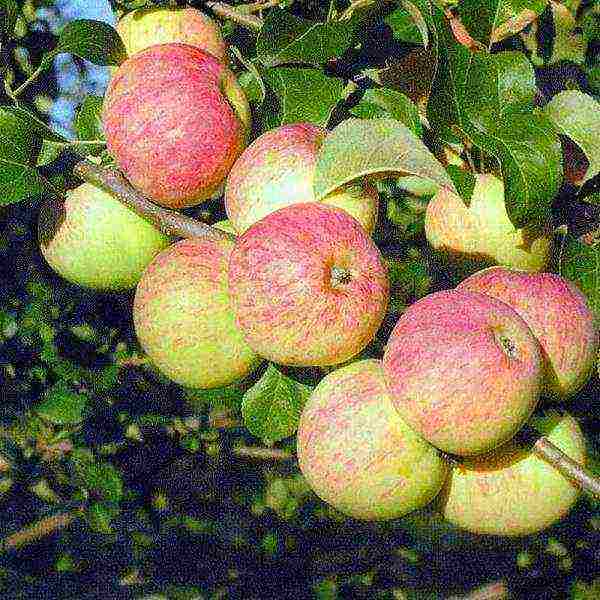
Tolunay.
Read more about the Tolunai apple variety in this article.
Ural bulk
The apples are small, greenish-yellow in color, but have a rather pleasant sweet and sour taste. Quickly begins to give the first harvests after planting - already for 2-3 years.
It is consumed both fresh and is excellent for processing. The yield is large.
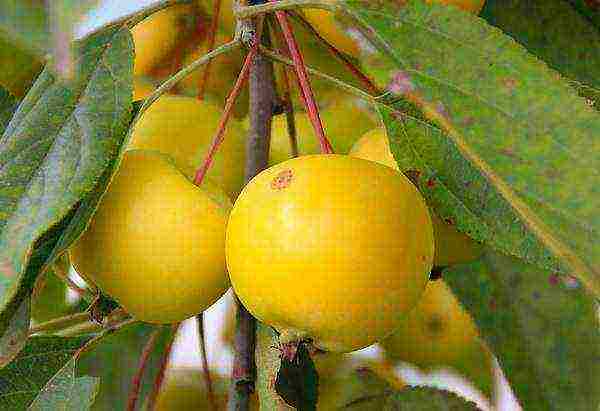
Ural bulk.
Read more about Yablon Uralskoe bulk read here.
Anise purple
A dense leafy crown with thick skeletal branches gives regular big harvest, which is up to 30 kg. The apples are juicy, 70 - 80 g each, with a wonderful wine-sweet taste and a relatively long shelf life.
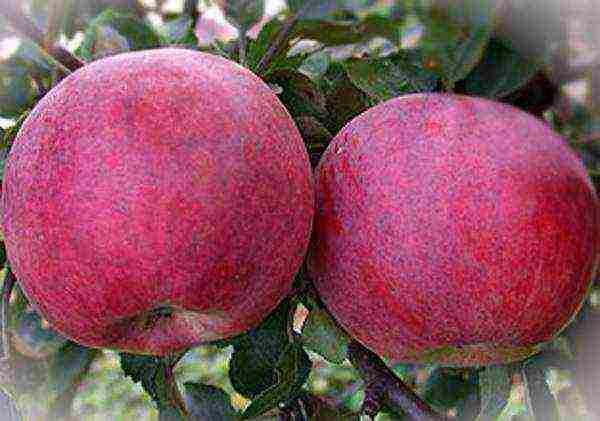
Anise purple.
Lungwort
Tall apple tree... The taste is well explained by the name of the hybrid. The crown thickens quickly, therefore requires annual thinning and shaping. Average fruit weight - 90 - 150 g. The color of apples is yellow with green, and various shades of red coating.
Attention! Possesses increased resistance to fungal diseases and rot.
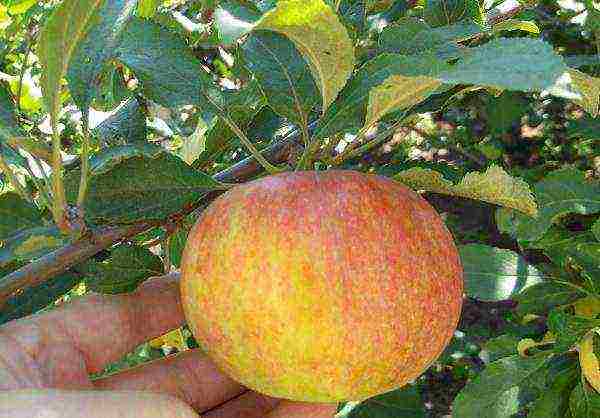
Lungwort.
You can read more information about the variety Medunitsa here.
Bayan
The height of an adult plant barely reaches 4 m. Begins to produce fruit 4 years after planting a one-year seedling. They are of average size 70 - 80 g. In good fruitful years and with thinning of the peduncles, the weight of some reached 140 g.
Possesses good keeping quality - 4 months... Slight freezing was observed only in very harsh winters.
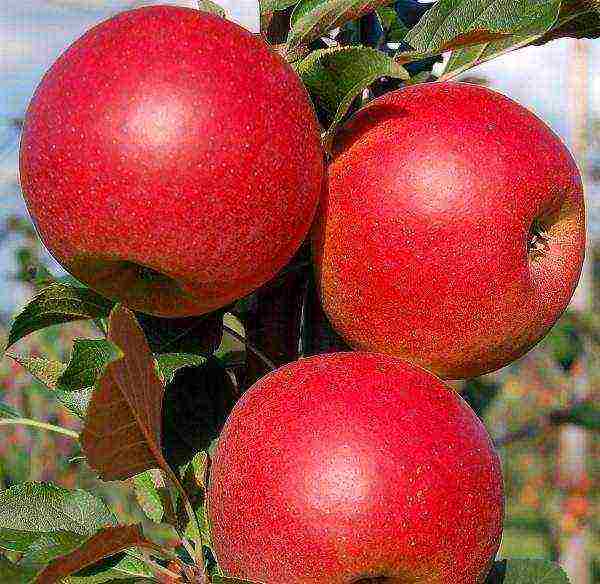
Bayan.
Read more about the Bayan apple variety in this article.
Altai souvenir
The plant has a small growth, with a thin crown and branches branching out almost at right angles. Apples 75 - 125 g, yellow with a pink streak coating. The pulp is fine-grained, juicy, tender, with the usual taste for this culture.
The shelf life of the crop is about 4 months.
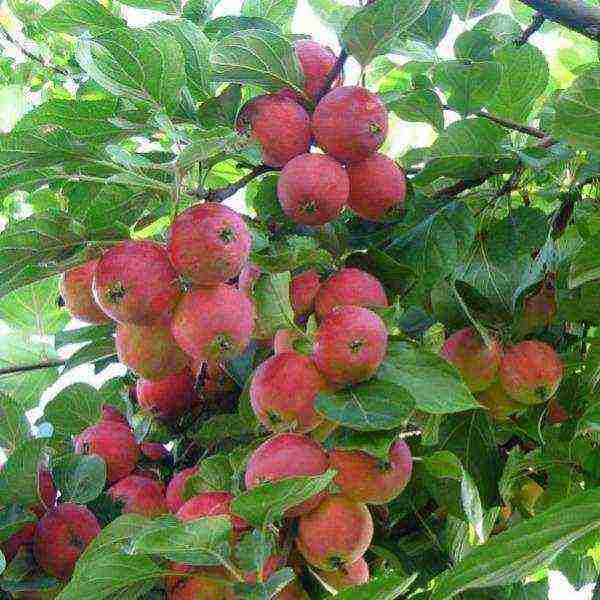
Altai souvenir.
Read more about the Altai Souvenir apple tree here.
Cherished
Early maturity attracts the attention of Siberian gardeners. Although it belongs to hybrids with average resistance to frost, it has won its place in Siberian gardens due to its resistance to diseases, small trees and very good yield indicators.
Taste qualities, small-sized fruits, with an unprecedented strawberry flavor and a long shelf life, are very much appreciated by gardeners.

Cherished.
Read more about the Cherished variety in this article.
Hope
Tall plant with small but tasty fruits. Resistant to all weather conditions... Scab is very rarely affected, and then only during the period of epiphytoties. It can retain consumer qualities for up to 90 days.
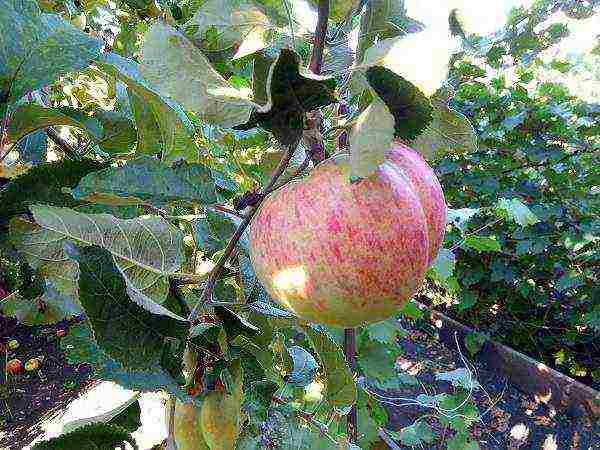
Hope.
Mountain synap
Rounded crown with sparse branches on a medium-sized plant. Good for the Siberian region fruit weight from 90 to 165 g. The main color of the fruit is golden with a ruddy finish. The palatability is quite good and has a tasting score of 4.7 points.
Characterized self-fertility, early maturity, sound and regular fruiting. They have a keeping quality until April.
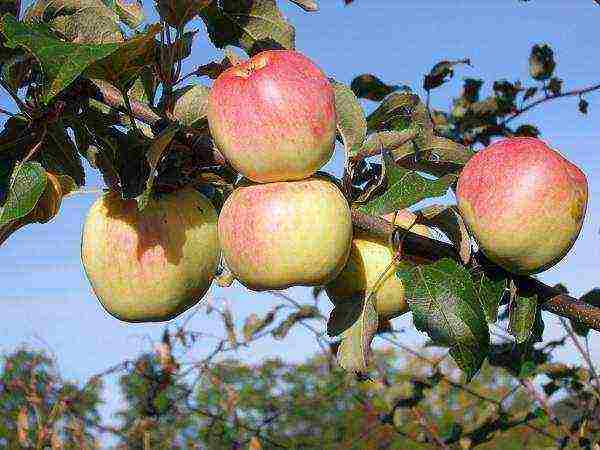
Mountain synap.
Read more about the Mountain Sinap apple tree in this article.
North synap
Tall plant with wide-pyramidal crown. For full ripening, the apple tree needs a long warm summer. Apples with an average weight of 110 g have good taste and a long shelf life.
The disadvantage is tall tree, uneven fruits and low indicators of their presentation with oversaturation of culture.
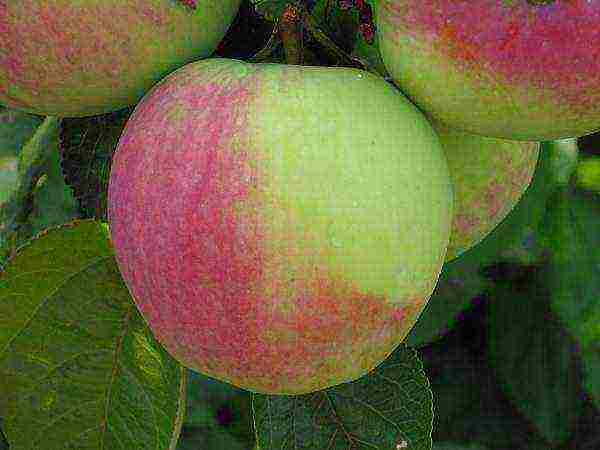
North Sinap.
Read more about the North Sinap apple tree here.
Varietal characteristics
Siberian apple trees should be divided into three groups. These are ranetki, semi-cultured and large-fruited. Large-fruited culture in Siberia mainly has a creeping shape.
Ranetki
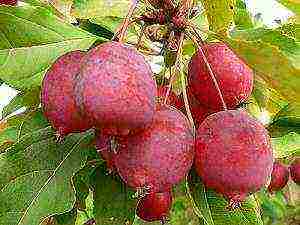 The most frost-resistant varieties and high-yielding apple trees. The apples are small, sour and tart. They are mainly used for processing and canning:
The most frost-resistant varieties and high-yielding apple trees. The apples are small, sour and tart. They are mainly used for processing and canning:
- Ranetka Ermolaeva;
- Change;
- For a long time;
- Barnaulochka;
- Dobrynya and others.
Semi-crops
Apple varieties of semi-crops have good taste... They are used fresh as well as for various blanks. Have different periods of maturation, storage and for the most part are fast-growing:
- Gornoaltaiskoe;
- Bayan;
- Ermakovskoe mountain;
- Altai souvenir;
- Alyonushka;
- Treasured, etc.
Large-fruited creeping
 They also have one more name - stlantsy. The quality is excellent, but winter hardiness is not increased. Therefore, this group needs a pre-winter shelter. Let's list the popular varieties (creeping apple trees):
They also have one more name - stlantsy. The quality is excellent, but winter hardiness is not increased. Therefore, this group needs a pre-winter shelter. Let's list the popular varieties (creeping apple trees):
- Melba;
- North Sinap;
- Welsey;
- White filling;
- Lungwort;
- Borovinka;
- some varieties of Antonovka, etc.
Planting and leaving
Landing
Timing
The best time to plant apple trees in harsh climates is Spring... Otherwise a young, fragile seedling, when planted in autumn, may not withstand severe frosts.
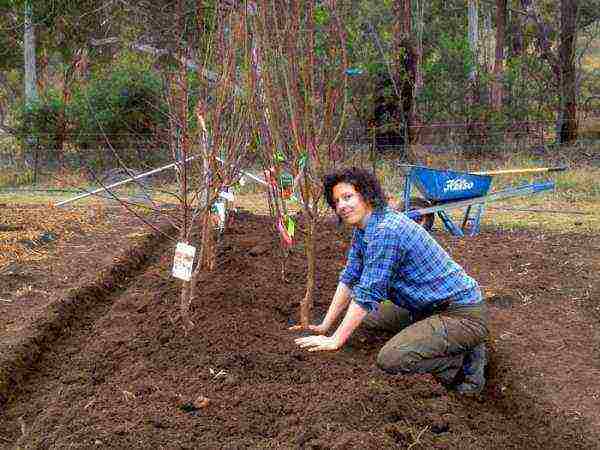
In Siberia, apple trees are planted in the spring.
It is worth noting that planting dates for Western and Eastern Siberia are the same, that is, planting apple trees in autumn in Tomsk, as well as in Krasnoyarsk, is not recommended.
Peculiarities
If the seedling is purchased in the fall, then it is better to dig it in with well-rotted humus before the onset of spring.
The features of spring planting are almost the same as in other regions of the country. A sunny, better windless place is selected. Closely located groundwater is destructive for this type of fruit. The soil should not be acidified.
The planting hole is dug in the fall. And in the spring, it is covered with fertile soil with fertilizers and a seedling is planted in it, which is spilled with high quality.
Growing apple trees
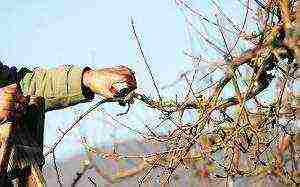 Crohn needs pruning and shaping throughout its life. If at a young age she stimulates the plant to branch more or to form fruit shoots, then in adulthood she needs sanitary pruning and rejuvenation measures.
Crohn needs pruning and shaping throughout its life. If at a young age she stimulates the plant to branch more or to form fruit shoots, then in adulthood she needs sanitary pruning and rejuvenation measures.
Caring for an apple tree in Siberia also includes fertilizing with fertilizers and mineral complexes. She compensates the wood for the lack of heat, sun and other components missing in a harsh climate.
Important! Any dressings are applied only on well-shed soil and not at the root, but in the area of the trunk circle in a groove specially prepared for this.
In such conditions practically does not need watering, unless there is dry and hot weather for a long time.
Preparation for the winter season is a must. The trunk circle is covered with humus or peat with a layer of at least 20 cm.
Such a process should take place gradually, increasing the layer with each decrease in temperature, so that the plant calmly goes into "hibernation". Besides after snow falls, the trunk circle is abundantly covered with it.
Diseases and varieties resistant to them
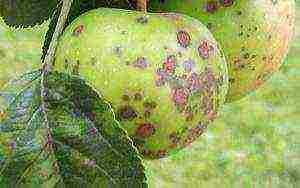 The apple tree has a lot of diseases and pests. And without preventive measures it is difficult to avoid any disease.
The apple tree has a lot of diseases and pests. And without preventive measures it is difficult to avoid any disease.
Modern hybrids are predominantly possess such dignity as resistance to the main disease of this culture - scab... But in epiphytotic years, the immunity grafted may not work. Only fungicides can save during such periods.
Milky sheen affection is widespread... Culture does not even have time to bloom. Drops flowers, branches begin to fade and after a while the branches dry up, their tips turn black.
Attention! Only preventive, annual, consistent spraying and proper maintenance will avoid this. Fully resistant hybrids have not yet been bred. Therefore, only prevention will save.
The most stable are:
- Welsey;
- Borovinka;
- Altai Bagryanoye;
- Antonovka;
- Lungwort;
- Altai souvenir.
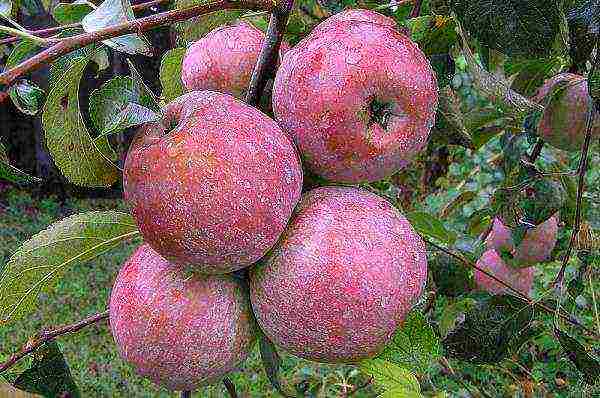
Welsey is one of the most resilient apple trees.
Varieties rating
By taste characteristics
The taste characteristics of the ranetki are not very good, as most of them have a sour and tart taste. Semi-crops have excellent taste. And large-fruited are not only tasty, but they have peculiar aromas.
| Name | Sugar content in% |
| Minusinskoe red | 15 |
| Lungwort | 14 |
| Altai Bagryanoye | 13.9 |
| Zhebrovskoe | 13.6 |
| Tolunay | 13 |
| Cherished | 12.2 |
| Ermakovskoe mountain | 11.5 |
| Gornoaltaiskoe | 11.5 |
| Altai souvenir | 11.3 |
| North synap | 11 |
| Spartan | 10.6 |
| Melba | 10.5 |
| Welsey | 10.1 |
By zoning
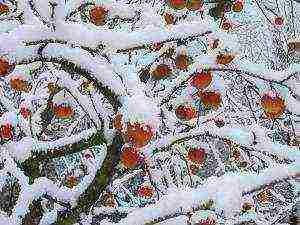 Apple trees grown in difficult climatic conditions, must have a high level of winter hardiness... All varieties with such indicators can be divided into:
Apple trees grown in difficult climatic conditions, must have a high level of winter hardiness... All varieties with such indicators can be divided into:
- low - winter hardy varieties;
- medium - frost-resistant;
- high - winter hardy.
The latter can withstand temperatures down to -45 °.
We should not forget about ripening period... In a short summer, this is very important. A full-fledged crop that has ripened to removable ripeness, can only give early and mid-early hybrids.
An important role is played by tree height... The taller ones are often prone to damage and death from winter winds.
Advice! Preference should be given to hybrids adapted to these climatic conditions. That is, zoned hybrids.
For Western Siberia
- Altai beauty;
- Altai amber;
- Bayan;
- Mountain synap;
- Surkhurai;
- Tolunay;
- Bow to Shukshin;
- Shushenskoye.
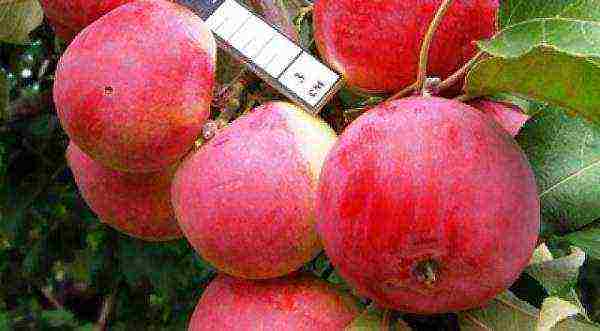
Shushenskoye.
For Eastern Siberia
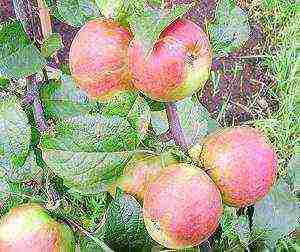
- Lydia;
- Pupil;
- Young Naturalist;
- Summer early;
- Red Melba;
- Krasnoyarsk sweet;
- Favorite Shevchenko;
- Minusinskoe Dessertnoe;
- Autumn Joy, etc.
By the characteristics of fruiting
With annual fruiting
Often in harsh Siberian conditions, apple trees switch to periodic fruiting. But there are varieties and hybrids that bear fruit almost every year:
- Altai sweet;
- Gornoaltaiskoe;
- Severyanka;
- Darkie and a number of other varieties.
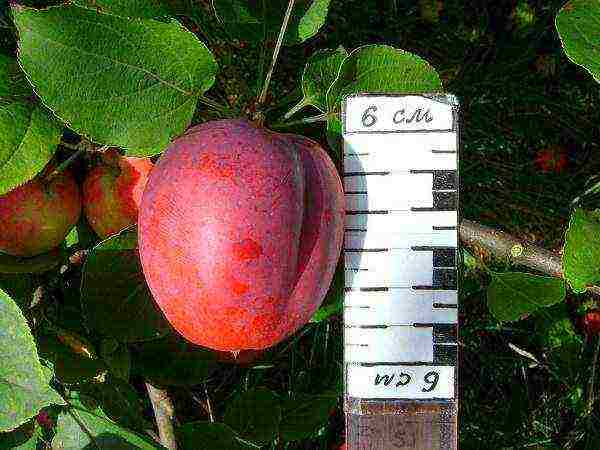
Darkie.
At a young age, most plants are able to yield a year if all the necessary conditions are created and the crown of the tree is formed correctly.
Long shelf life
 If in the recent past Siberian fruit growers could not ensure the safety of the harvest for more than a month, now a considerable amount of the most demanded fruit crop with keeping quality of apples from 3 to 6 months.
If in the recent past Siberian fruit growers could not ensure the safety of the harvest for more than a month, now a considerable amount of the most demanded fruit crop with keeping quality of apples from 3 to 6 months.
An example would be:
- Cherished;
- Altynai;
- Gift for gardeners;
- Bayan;
- Altai souvenir;
- Hope;
- Altai winter and purple and many others.
Large-fruited
According to information in the literature, no more than a dozen large-fruited or relatively large-fruited apple trees can be grown in Siberia. But according to many experienced gardeners, their number is much higher. The books say that grapes cannot be grown in such harsh conditions, but they are successfully grown.
Large-fruited for Siberia can be considered:
- White filling;
- Melba;
- Welsey;
- Anise;
- Aport;
- Borovinka;
- Grushovka Moscow, etc.

Borovinka.
There is a considerable amount of varietal material that can ripen in the short Siberian summer and bear relatively large fruits.
Types of apple trees for Siberia
Columnar
Experienced gardeners it is advised not to mess with columnar species in such a harsh climate. But still they are trying to grow and many are successful at it. True, you have to protect them with a shelter from frost and pay more attention.
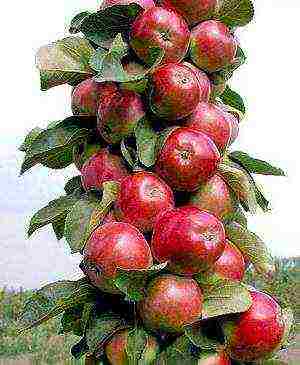 The following can be attributed to winter-hardy:
The following can be attributed to winter-hardy:
- Senator - apples of medium size, dark red when ripe. Plant resistance to powdery mildew is high. Tolerant to other diseases. Sweet, juicy taste;
- The President is considered one of the best for Siberian conditions. The fruits are rather large, reaching 250 g, sweet and sour taste with a long-lasting aroma;
- The currency is uniquely resistant to disease. Possesses good keeping quality and dessert taste, medium-sized apples;
- Medoc - apples of honey flavor. The shelf life is about one and a half months. Very frost resistant;
- Iksha are ideal fruits for preserves and jams. Differs in a high content of fructose in the composition. Resistant to many diseases.
Also quite frost-resistant varieties are:
- Ostankino;
- Vasyugan;
- Chervonets;
- Sparkle;
- Dialog;
- Triumph, etc.
Dwarf
Most people want to have small fruit trees in the garden that are easy to maintain and do not take up much space. BUT grafted onto a dwarf stock still begin to bear fruit much earlier and are more frost-resistant than other species.
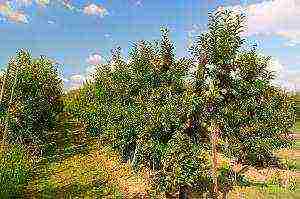 The most popular dwarf ones are:
The most popular dwarf ones are:
- Zhigulevskoe;
- Russian beauty;
- Aport;
- Zarya Alatau;
- Welsey et al.
Stamp
Autumn standard ones are more adapted for harsh climates... And the fruits have time to ripen with good qualities. This is:
- Ural bulk;
- Anise purple;
- High;
- Gornoaltaiskoe;
- Memory of Zhavoronkov;
- Hope;
- Miasskoe.
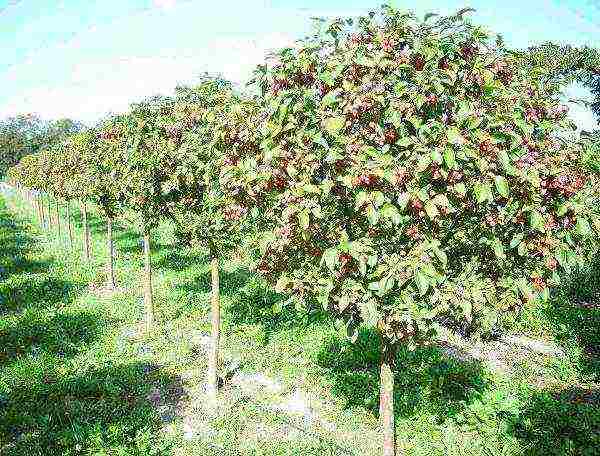
Stamp apple trees.
Useful videos
Watch a video about apple varieties for Siberia:
Watch a video on how to plant an apple tree in Siberia:
Watch the video on how to form a creeping apple tree:
Watch a video on how to prepare apple trees for winter:
Conclusion
Harsh, long winters and short summer heat - all this sets certain tasks not only for beginners, but also for experienced fruit growers.
Therefore, the main attention should be paid to characteristics and references, and culture should be given more attention and care. Only in this case, the garden will delight you with the beautiful flowering of apple trees and decent fruiting.
On our site you can find the most popular apple varieties for Siberia and the Urals with photos and descriptions.
